emergency towing AUDI A4 AVANT 2008 Owners Manual
[x] Cancel search | Manufacturer: AUDI, Model Year: 2008, Model line: A4 AVANT, Model: AUDI A4 AVANT 2008Pages: 368, PDF Size: 46.19 MB
Page 5 of 368
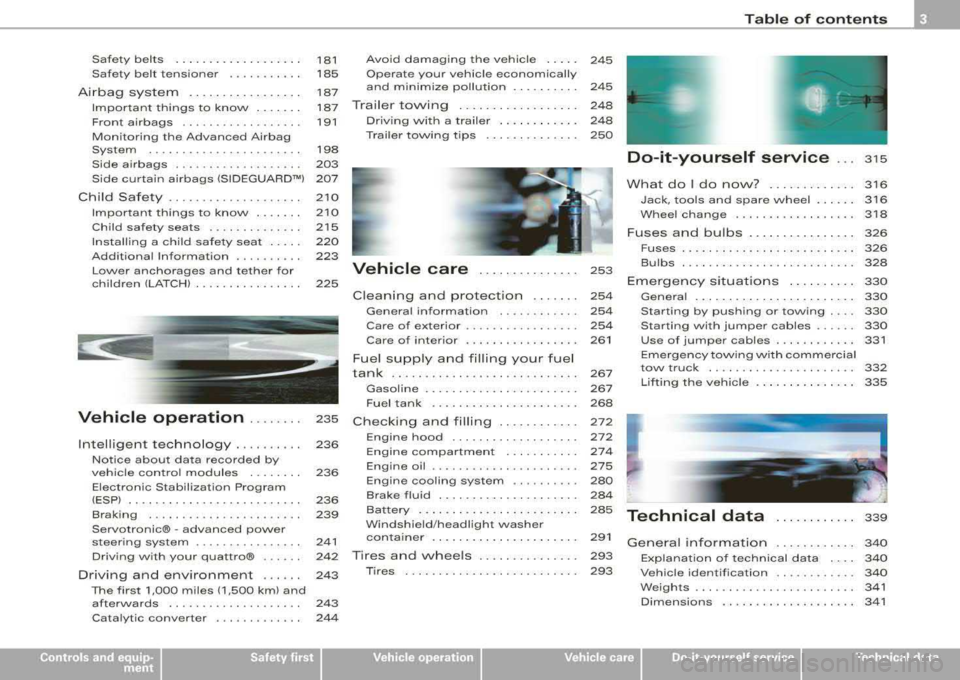
Safety belts .................. .
Safety belt tensioner ..... ... .. .
Airbag system ........ .... .. .. .
Important th ings to know .. .... .
Front airbags .. ... .. ... ...... . .
Monitoring the Advanced Airbag
System ... ..... .... ..... .. ... .
Side airbags .... ... ...... ..... .
Side curtain airbags (SIDEGUARD™l
Child Safety .. ... ... ..... ... ... .
Important things to know .... .. .
Child safety seats ........ ... .. .
Insta lling a ch ild safety seat .... .
Addit ional Information .... ..... .
Lower anchorages and tether for
chi ldren (LA TCH) .......... ... .. .
t
181
185
187
187
191
198
203 207
210
210
215
220
223
225 Avoid damag
ing the vehicle .....
Operate your vehicle economically
and minimize pollution ......... .
Trailer towing .......... ... .. .. .
Driv ing w it h a trailer ... .... .... .
Trai ler towing t ips ....... ...... .
Vehicle care ........ ... ... .
C lean ing and protection ...... .
Genera l information ........... .
Care of exterior ....... .. .. .. ... .
Care of interior ................ .
Fuel supply and filling your fuel
tank ........ .... .. ... .... ...... .
245
245
248
248
250
253
254
254
254
261
267
Gasoline . . . . . . . . . . . . . . . . . . . . . . . 267
Fuel tank . . . . . . . . . . . . . . . . . . . . . . 268
Vehicle operation . . . . . . . . 235 Checking and filling . . . . . . . . . . . . 212
Intelligent technology ... ...... .
Notice about data recorded by
veh icle contro l modules ....... .
Electronic Stabilization Program
(ESP) ......................... .
Braking .. ... ... ... ... ... .. ... .
Servotronic®
-advanced power
steering system . ......... .. ... . 236
236
236
239
241
Driv ing w ith your quattro® . . . . . . 242
Driving and environment . . . . . . 243
The first 1,000 miles (1,500 kml and
afterwards . . . . . . . . . . . . . . . . . . . . 243
Cata lytic conver ter . . . . . . . . . . . . . 244 Engine
hood ......... ......... .
Engine compartmen t .... ... ... .
Engine oil ... ...... ... ....... .. .
Engine cooling system .. .... ... .
Brake fluid . ............... .... .
Ba ttery ...... .......... .... ... .
Windshield/headlight washer
con ta iner .. ........ ... ........ .
Tires and whee ls ..... ......... .
Tires .......... ...... .. .. ..... . 272
2 74
275
280
284
285
291
293
293
Tabl e of cont ents
Do-it-yourself service . . . 3 15
What do I do now? . ......... ... 316
Jack, tools and spare wheel . . . . . . 316
W hee l change ............... ... 318
Fuses and bulbs . . . . . . . . . . . . . . . . 326
Fuses ........ ......... ..... .... 326
Bu lbs .............. ... ... ... ... 328
Eme rgency sit uations . . . . . . . . . . 330
Genera l . . . . . . . . . . . . . . . . . . . . . . . . 330
Starting by pushing or towing . . . . 330
Starting with jumper cables . . . . . . 330
Use of jumper cables . . . . . . . . . . . . 331
Emergency tow ing with comme rcial
tow truck . . . . . . . . . . . . . . . . . . . . . . 332
Lif ting the vehicle . . . . . . . . . . . . . . . 335
Technical data
General in for matio n
339
340
E xplanat ion of technical data . . . . 340
Vehicle identification . . . . . . . . . . . . 340
Weights . . . . . . . . . . . . . . . . . . . . . • . . 341
Dimensions . . . . . . . . . . . . . . . . . . . . 341
irechnical data
Page 138 of 368
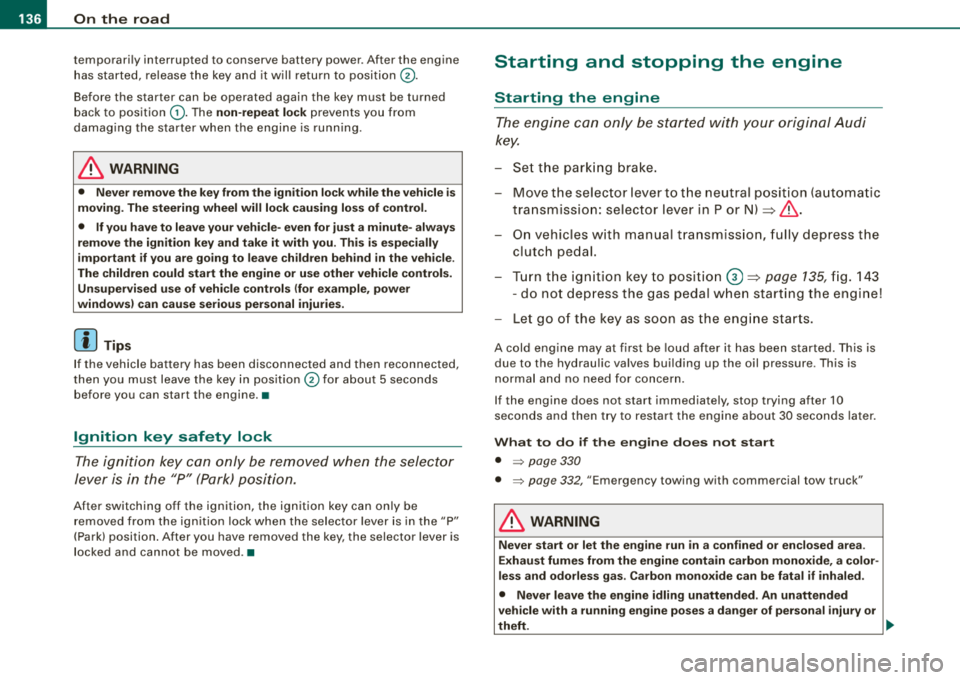
___ o_ n_ t_h _e _ r_o _a_ d __________________________________________________ _
temporarily interrupted to conserve battery power. After the engine
has started, release the key and it will return to position
0-
Before the starter can be operated again the key must be turned
back to position
G) . The non-repeat lock prevents you from
damaging the starter when the engine is running.
_& WARNING
• Never remove the key from the ignition lock while the vehicle is
moving. The steering wheel will lock causing loss of control.
• If you have to leave your vehicle-even for just a minute- always
remove the ignition key and take it with you. This is especially
important if you are going to leave children behind in the vehicle.
The children could start the engine or use other vehicle controls.
Unsupervised use of vehicle controls (for example, power
windows) can cause serious personal injuries.
[ i] Tips
If the vehicle battery has been disconnected and then reconnected,
then you must leave the key in position
0 for about 5 seconds
before you can start the engine. •
Ignition key safety lock
The ignition key can only be removed when the selector
lever is in the
"P" (Park) position.
After switching off the ignition, the ignition key can only be
removed from the ignition lock when the selector lever is in the
"P"
(Park) position. After you have removed the key, the selector lever is
locked and cannot be moved. •
Starting and stopping the engine
Starting the engine
The engine can only be started with your original Audi
key.
-Set the parking brake.
-Move the selector lever to the neutral position (automatic
transmission: selector lever in P or N)
=> & .
-On vehicles with manual transmission, fully depress the
clutch pedal.
-Turn the ignition key to position 0 => page 135, fig. 143
- do not depress the gas pedal when starting the engine!
-Let go of the key as soon as the engine starts.
A cold engine may at first be loud after it has been started. This is
due to the hydraulic valves building up the oil pressure . This is
normal and no need for concern.
If the engine does not start immediately, stop trying after 10
seconds and then try to restart the engine about 30 seconds later.
What to do if the engine does not start
• ~ page 330
• ~ page 332, "Emergency towing with commercial tow truck"
_& WARNING
Never start or let the engine run in a confined or enclosed area.
Exhaust fumes from the engine contain carbon monoxide, a color
less and odorless gas. Carbon monoxide can be fatal if inhaled.
• Never leave the engine idling unattended. An unattended
vehicle with a running engine poses a danger of personal injury or
theft.
~
Page 320 of 368

___ w_ h_ a_t _ d_ o_ l_d _ o_ n_ o_w _ ? ______________________________________________ _
Storing the replaced wheel
- Place the replaced wheel inside the spare wheel well in
the luggage compartment.
- Tighten the knurled retaining screw clockwise to secure
the wheel in place.
- Disengage and lower the floor panel before you close the
luggage compartment lid again.
& WARNING
Loose items in the passenger compartment can cause serious
personal injury during hard braking or in an accident.
• Never store the spare wheel or jack and tools
in the passenger
compartment.
• Always store all jacking equipment, tools, and the spare wheel
in the luggage compartment.
• Tighten the knurled retaining screw for the spare wheel
securely.
[ i] Tips
Check the inflation pressure of the spare tire periodically to keep the
tire ready for use. •
Wheel change
Before changing a wheel
Follow these points for your own and your passenger's
safety when replacing a wheel.
After you experience a tire failure, pull the car well away
from moving traffic and try to reach
level ground before
you
stop ~& .
-All passengers should leave the car and move to a safe
location (for instance, behind the
guardrail) ~& .
-Apply the parking brake firmly ~& .
-Move selector lever to position P on an automatic trans-
mission; put manual transmission in
first gear~& .
-If you are towing a trailer: unhitch the trailer from your
vehicle.
- Take the
tool case and the spare tire ~ page 316 out of
the luggage compartment.
& WARNING
You or your passengers could be injured while changing a wheel if
you do not follow these safety precautions:
• If you have a flat tire, move a safe distance off the road. Turn off
the engine, turn the emergency flasher on and use other warning
devices to alert other motorists.
• Make sure that passengers wait
in a safe place away from the
vehicle and well away from the roadway and traffic.
• To help prevent the vehicle from moving suddenly and possibly
slipping off the jack, always fully set the parking brake and block
the wheel diagonally opposite the wheel being changed . When one
front wheel is lifted off the ground, placing the Automatic Trans-
~
Page 332 of 368
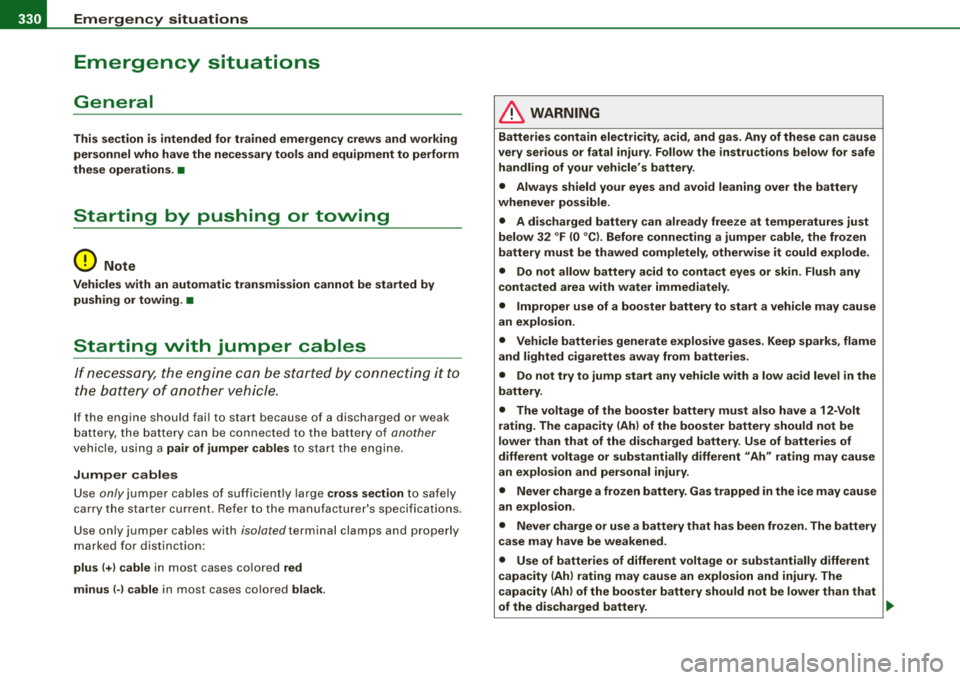
lllft!l.,___E
_ m_ e_r-=g =-e_ n_c ..:y:- s_ i_ t _u _a_ t_ i_ o _n_ s _______________________________________________ _
Emergency situations
General
This section i s intended for trained emergency crews and working
personnel who have the necessary tools and equipment to perform
these operations.
•
Starting by pushing or towing
0 Note
Vehicles with an automatic transmission cannot be started by
pushing or towing . •
Starting with jumper cables
If n ece ssary, the eng in e can b e star ted by conne cting it to
the battery of another veh ic le .
If th e engin e shou ld fai l to start because of a discharged or weak
b at te ry, the batt ery can be co nnected t o the ba ttery of
another
ve hic le, us ing a pair of jumper cables to start the engine.
Jumper cables
Use
only jumper cables of sufficient ly large cross se ction to safe ly
c a rry the st ar ter curr ent. Refer to th e m anuf actu rer's specific ations.
Us e on ly j um per ca bles with
isolated term ina l clam ps and prop erly
marked for distinction:
plus (+l cable in most c ases c olored red
minus (- l cable in most cases co lored black .
& WARNING
Batteries contain electricity , acid, and gas . Any of these can cause
very serious or fatal injury. Follow the instructions below for safe
handling of your vehicle 's battery.
• Always shield your eyes and avoid leaning over the battery
whenever possible .
• A discharged battery can already freeze at temperatures just
below 32 °F (0 °Cl. Before connecting a jumper cable, the frozen
battery must be thawed completely , otherwise it could explode.
• Do not allow battery acid to contact eyes or skin . Flush any
contacted area with water immediately .
• Improper use of a booster battery to start a vehicle may cause
an explosion.
• Vehicle batteries generate e xplosive gases . Keep sparks, flame
and lighted cigarettes away from batteries.
• Do not try to jump start any vehicle with a low ac id level in the
battery.
• The voltage of the booster battery must also have a 12-Volt
rating . The capacity (Ahl of the booster battery should not be
lower than that of the discharged battery . Use of batteries of
different voltage or substantially different
" Ah " rating may cause
an e xplosion and personal injury .
• Never charge a frozen battery. Gas trapped in the ice may cause
an explosion .
• Never charge or use a battery that has been frozen . The battery
case may have be weakened.
• Use of batteries of different voltage or substantially different
capacity (Ah ) rating may cause an explosion and injury . The
capacity (Ah l of the booster battery should not be lower than that
of the discharged battery . ..,_
Page 334 of 368
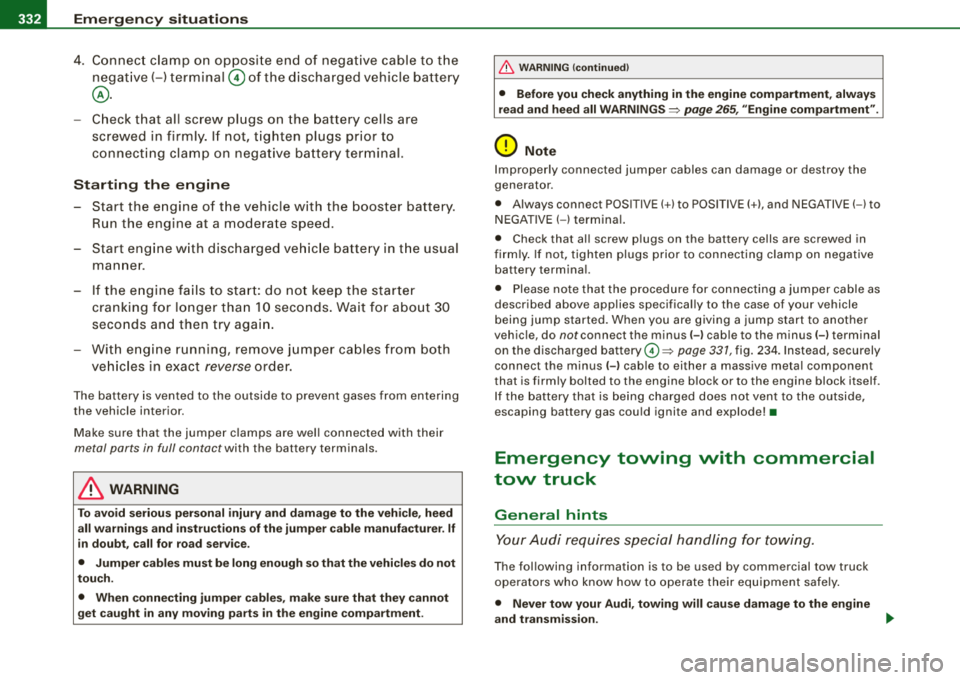
-Emergency situations PW--------=----=---------------
4. Connect clamp on opposite end of negative cable to the
negative(-) terminal© of the discharged vehicle battery
@.
- Check that all screw plugs on the battery cells are
screwed in firmly. If not, tighten plugs prior to
connecting clamp on negative battery terminal.
Starting the engine
-Start the engine of the vehicle with the booster battery.
Run the engine at a moderate speed.
- Start engine with discharged vehicle battery in the usual
manner .
- If the engine fails to start: do not keep the starter
cranking for longer than 10 seconds. Wait for about 30
seconds and then try again.
- With engine running, remove jumper cables from both
vehicles in exact
reverse order.
The battery is vented to the outside to prevent gases from entering
the vehicle interior.
Make sure that the jumper clamps are well connected with their
metal parts in full contact with the battery terminals .
& WARNING
To avoid serious personal injury and damage to the vehicle, heed
all warnings and instructions of the jumper cable manufacturer. If
in doubt, call for road service.
• Jumper cables must be long enough so that the vehicles do not
touch.
• When connecting jumper cables, make sure that they cannot
get caught in any moving parts in the engine compartment.
& WARNING (continued)
• Before you check anything in the engine compartment, always
read and heed all
WARNINGS:::::, page 265, "Engine compartment".
0 Note
Improperly connected jumper cables can damage or destroy the
generator .
• Always connect POSITIVE (+l to POSITIVE(+), and NEGATIVE (-l to
NEGATIVE (- l terminal.
• Check that all screw plugs on the battery cells are screwed in
firmly. If not, tighten plugs prior to connecting clamp on negative
battery terminal.
• Please note that the procedure for connecting a jumper cable as
described above applies specifically to the case of your vehicle
being jump started. When you are giving a jump start to another
vehicle, do not connect the minus 1-1 cable to the minus (-1 terminal
on the discharged battery @::::, page 331, fig. 234. Instead, securely
connect the minus (-l cable to either a massive metal component
that is firmly bolted to the engine block or to the engine block itself .
If the battery that is being charged does not vent to the outside,
escaping battery gas could ignite and explode! •
Emergency towing with commercial
tow truck
General hints
Your Audi requires special handling for towing.
The following information is to be used by commercial tow truck
operators who know how to operate their equipment safely.
• Never tow your Audi, towing will cause damage to the engine
and transmission. .,_
Page 335 of 368
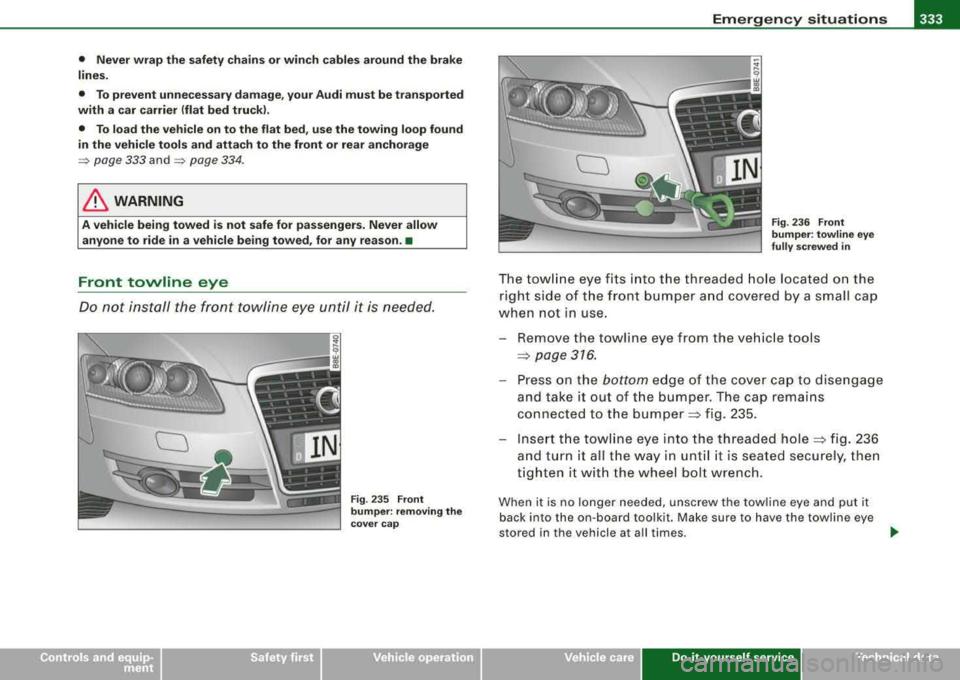
Emergency situations -
----------------=-----'
• Never wrap the safety chains or winch cables around the brake
lines.
• To prevent unnecessary damage, your Audi must be transported
with a car carrier (flat bed truck).
• To load the vehicle on to the flat bed, use the towing loop found
in the vehicle tools and attach to the front or rear anchorage
=> page 333 and => page 334.
& WARNING
A vehicle being towed is not safe for passengers. Never allow
anyone to ride in a vehicle being towed, for any reason. •
Front towline eye
Do not install the front towline eye until it is needed.
Fig. 235 Front
bumper: removing the
cover cap Fig. 236 Front
bumper: towline eye
fully screwed in
The towline eye fits into the threaded hole located on the
right side of the front bumper and covered by a small cap
when not in use .
-Remove the towline eye from the vehicle tools
=} page 316.
-Press on the bottom edge of the cover cap to disengage
and take it out of the bumper. The cap remains
connected to the bumper :::} fig. 235.
-Insert the towline eye into the threaded hole:::} fig. 236
and turn it all the way in until it is seated securely, then
tighten it with the wheel bolt wrench.
When it is no longer needed, unscrew the towline eye and put it
back into the on-board toolkit. Make sure to have the towline eye
stored in the vehicle at all times. .,_
Do-it-yourse lf service irechnical data
Page 357 of 368
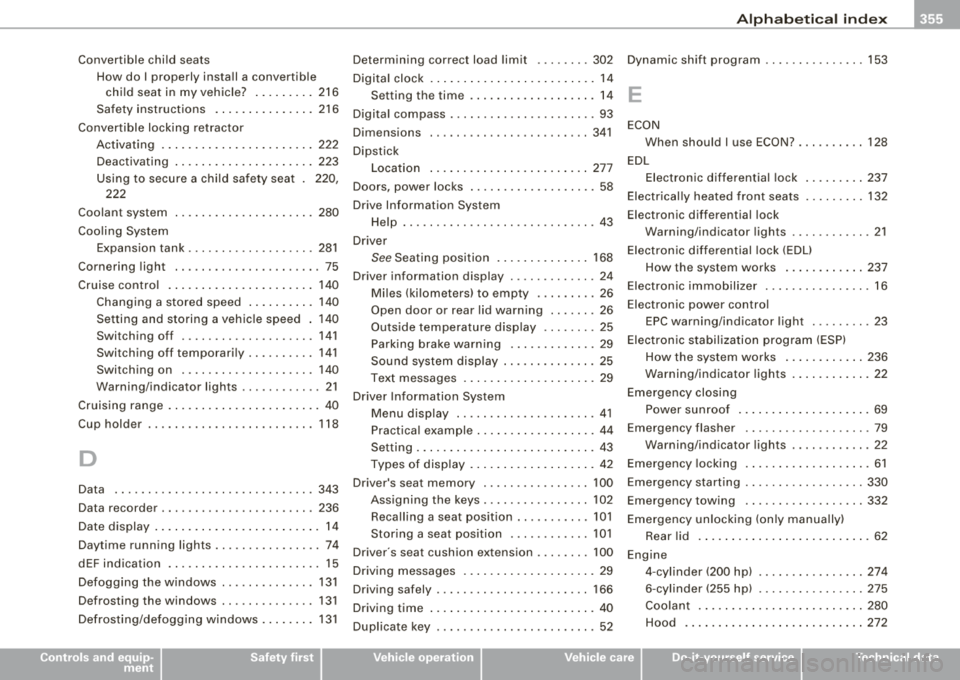
Alphabetical index -
-------------=----
Convertible child seats
How do I properly ins ta ll a conve rtible
child seat in my vehicle? ......... 216
Safety instructions . ...... ...... .. 216
Convertible locking retractor
Act ivating .. .. .... .... ........... 222
Deactivating ...... .... ........... 223
Using to secure a child safety seat 220,
222
Coolant system ... .. .... .... ........ 280
Coo ling System
Expansion tank .... ....... ... .... . 281
Cornering light .. .... .... ...... .... .. 75
Cruise control . ...... .... ........... 140
Changing a stored speed .... ... .. . 140
Setting and storing a vehic le speed . 140
Switching off . ........... .... .... 141
Switching off temporari ly .......... 141
Switching on .... .... .... .... .... 140
Warning/indicator lights .. ... .... ... 21
Cruising range .................. ..... 40
Cup holder ......................... 118
D
Data .............................. 343
Data recorder ... .... .... .... ..... .. . 236
Date display ......................... 14
D aytime running lights ................ 74
dEF indication .............. ......... 15
Defogging the windows .. .... .... .... 131
Defrosting the windows ...... .... .... 131
Defrosting /defogging windows .. .... .. 131
Controls and equip
ment Safety first
Determining
correct load limit ..... .. . 302 Dynamic shift program ... .... ...... .. 153
Digita l clock .. ...... ..... .. .... .... .. 14
Setting the time ..... ...... .... .... 14
E
Digita l compass ...................... 93
Dimensions . ....... ... .. .... .... ... 341
Dipstick Location .... .... ... .. .... .... ... 277
Doors, power locks .. ...... ....... .... 58
Drive Information System Help .. ...... .... ... .. .... .... .... 43
Driver
See Seating position ........... ... 168
Driver information display ....... .... .. 24
Mi les (ki lometers) to empty .... ... .. 26
Open door or rear lid warning .. .... . 26
Outside
temperatu ire disp lay ....... . 25 ECON
When should I use ECON? ...... ... . 128
EDL Electronic differential lock .... .... . 237
Ele ctrically heated front seats ..... ... . 132
Electronic differential lock
Warning/indicator lights ...... .... .. 21
Electronic differential lock (EDU
How the system works ............ 237
Elect ronic immobilizer . ... .... .... .... 16
Electronic power contro l
EPC warning/indicator light ....... .. 23
Parking brake warning .. .... ... .. .. 29 Electronic stabilization program
(ESP)
Sound system display
...... .... .... 25 How
the system works ............ 236
Text messages .. ....... ...... .... . 29 Warning/indicator
lights ...... ...... 22
Driver Informa tion System Emergency
closing
Menu display .. ... .... .... .... ... . 41 Power sunroof ...
.... ........... .. 69
Practical example .................. 44 Emergency
flasher .. ... .... .... ...... 79
Setting .. .... ....... ...... .... .... 43 Warning/indicator
lights ...... ...... 22
Types of disp lay ..... ...... ... .... . 42 Emergency
locking ................... 61
Driver's seat memory ................ 100 Emergency
starting ... .... ... .... .... 330
Assigning the keys ....... ... .. .... 102
Emergency towing .................. 332
Recalling a seat position .. .... .... . 101
Emergency un locking (on ly manually)
Storing a seat position ............ 101
Rear lid . ... .. .... .... ...... .... .. 62
Driver's seat cushion extension ...... .. 100
Engine
Driving messages .... .... .... .... .... 29
4-cylinder (200 hp) ...... .. .... .... 274
Driving safely ....... ... .. .... .... ... 166 6-cylinder (255
hp) ................ 275
Driving time ... .. ...... .... ... .. .... . 40 Coolant
......................... 280
Dup licate key .... .... .... ...... ... .. . 52 Hood ......
...... .... ...... ..... 272
Vehicle operation Vehicle care Do-it-yourself service Technical data
Page 360 of 368
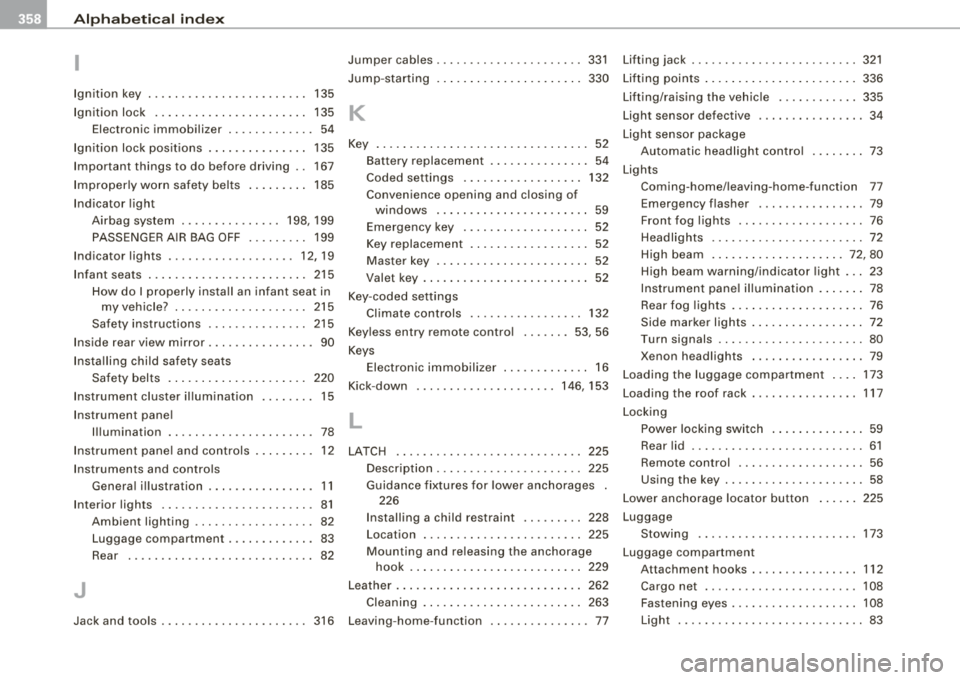
-Alphabetical index
---=------------------------------------------------
I
Ignition key 135
Ignition lock ... ... .. .... .... ...... . 135
Electronic immobiliz er ..... ........ 54
Ignition lock posit ions .... .... ...... . 135
167
185
Impor
tant things to do before driving ..
Improperly worn safety belts
Ind icator light
Airbag system . . . . . . . . . . . . . . . 198 , 199
PASSENGER AIR BAG OFF ......... 199
Indica tor lights . . . . . . . . . . . . . . . . . . . 12, 19
Infant seats . . . . . . . . . . . . . . . . . . . . . . . . 215
How do I properly install an infa nt seat in
my vehicle? .............. ...... 215
Safety instructions . . . . . . . . . . . . . . . 215
Ins ide rear view mirror .... ....... .... . 90
Installing child safety seats
Safety belts . . . . . . . . . . . . . . . . . . . . . 220
Inst rument cluster il lum ination ........ 15
In strument panel
Illum ination ...... ........ ... .... . 78
Inst rument panel and controls .. ....... 12
Ins truments and controls
Genera l ill ustration .... ....... .... . 11
In terior lights ....................... 81
Ambient lighting .................. 82
Luggage compartment ............. 83
Rear ............................ 82
J
Jack and tools . . . . . . . . . . . . . . . . . . . . . . 316 Jumper cables
.......... .... .... .... 331
Jump -starting 330
K
Key ...... ..... .. ...... .... ... .. .... 52
Battery replacement . . . . . . . . . . . . . . . 54
Coded settings .. .... ....... ..... 132
Convenience opening and closing of windows ... .... ... .. .... .... ... 59
Emergency key . . . . . . . . . . . . . . . . . . . 52
Key replacement . . . . . . . . . . . . . . . . . . 52
Master key .......... ...... .... ... 52
Valet key . . . . . . . . . . . . . . . . . . . . . . . . . 52
Key-coded settings Climate controls .. ........ ....... 132
Keyl ess entry remote control
Keys 53, 56
Electronic immobilizer ...... .... ... 16
Kick-down ...... ....... ...... .. 146, 153
L
LATCH ............................ 225
Description ...................... 225
Guidance fixtures for lower anchorages .
226
Ins talling a child restraint .. .. .. ... 228
Location ......... .... .... .... ... 225
Mounting and re leasing the anchorage
hook .. ...... ...... .... ... .. ... 229
Leather ..... .. ...... ... .. .... .... .. 262
Cleaning ........................ 263
Le aving -home-function ............... 77 Lifting jack
......... .... .... .... .... 321
Lifting points ...... ...... ... .. .... .. 336
Lifting/raising the vehic le ............ 335
Light sensor defective ................ 34
Light sensor package
Automatic headlight contro l .. .. ... . 73
Lights Coming-home/leaving-home-function 77
Emergency flasher ................ 79
Front fog lights ............... .... 76
Headlights ....................... 72
High beam ..... .. .... .... .... . 72, 80
High beam warning/indicator light .. . 23
Instrument pane l il lumination . ...... 78
Rear fog lights ..... ............... 76
Side marker lights ................. 72
Turn signals ...................... 80
Xenon headlights ...... ..... .. .... 79
Loading the luggage compartment ... . 173
Loading the roof rack .. ....... .... ... 117
Locking Power locking switch .............. 59
Rear lid .......................... 61
Remote control . . . . . . . . . . . . . . . . . . . 56
Using the key .. .... .... ..... .. .... 58
Lower anchorage locator button ...... 225
Luggage Stowing ........................ 173
Luggage compartment Attachment hooks . ........ .... ... 112
Cargo net .... .... .... ........... 108
Fastening eyes ................... 108
Light ............................ 83